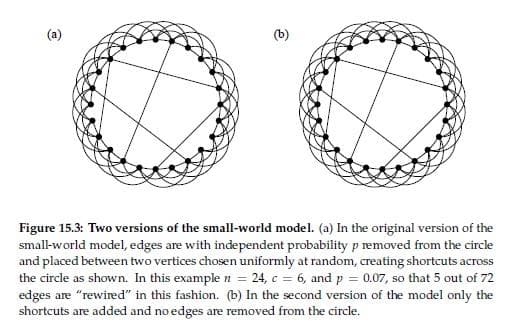5. Newman, Networks 2010 15.2) One of the difficulties with the original small-world model depicted in Fig. 15.3a is that vertices can become disconnected from the rest of the network by the rewiring process. For instance, a single vertex can become disconnected if all of its incident edges around the ring are rewired and it has no shortcuts. a) Show that the probability of this happening to any given vertex is [pe^(−p)]^c. b)
5. Newman, Networks 2010 15.2) One of the difficulties with the original small-world model depicted in Fig. 15.3a is that vertices can become disconnected from the rest of the network by the rewiring process. For instance, a single vertex can become disconnected if all of its incident edges around the ring are rewired and it has no shortcuts. a) Show that the probability of this happening to any given vertex is [pe^(−p)]^c. b)
Computer Networking: A Top-Down Approach (7th Edition)
7th Edition
ISBN:9780133594140
Author:James Kurose, Keith Ross
Publisher:James Kurose, Keith Ross
Chapter1: Computer Networks And The Internet
Section: Chapter Questions
Problem R1RQ: What is the difference between a host and an end system? List several different types of end...
Related questions
Question
5.
Newman, Networks 2010
15.2) One of the difficulties with the original small-world model depicted in Fig. 15.3a
is that vertices can become disconnected from the rest of the network by the rewiring
process. For instance, a single vertex can become disconnected if all of its incident edges
around the ring are rewired and it has no shortcuts.
a) Show that the probability of this happening to any given vertex is [pe^(−p)]^c.
b) Hence, how large must the network be before we expect that one vertex will be
disconnected, if c = 6 and p = 0.01?

Transcribed Image Text:Figure 15.3: Two versions of the small-world model. (a) In the original version of the
small-world model, edges are with independent probability p removed from the circle
and placed between two vertices chosen uniformly at random, creating shortcuts across
the circle as shown. In this example n = 24, c = 6, and p = 0.07, so that 5 out of 72
edges are "rewired" in this fashion. (b) In the second version of the model only the
shortcuts are added and no edges are removed from the circle.
Expert Solution
This question has been solved!
Explore an expertly crafted, step-by-step solution for a thorough understanding of key concepts.
This is a popular solution!
Trending now
This is a popular solution!
Step by step
Solved in 2 steps with 2 images

Recommended textbooks for you

Computer Networking: A Top-Down Approach (7th Edi…
Computer Engineering
ISBN:
9780133594140
Author:
James Kurose, Keith Ross
Publisher:
PEARSON

Computer Organization and Design MIPS Edition, Fi…
Computer Engineering
ISBN:
9780124077263
Author:
David A. Patterson, John L. Hennessy
Publisher:
Elsevier Science

Network+ Guide to Networks (MindTap Course List)
Computer Engineering
ISBN:
9781337569330
Author:
Jill West, Tamara Dean, Jean Andrews
Publisher:
Cengage Learning

Computer Networking: A Top-Down Approach (7th Edi…
Computer Engineering
ISBN:
9780133594140
Author:
James Kurose, Keith Ross
Publisher:
PEARSON

Computer Organization and Design MIPS Edition, Fi…
Computer Engineering
ISBN:
9780124077263
Author:
David A. Patterson, John L. Hennessy
Publisher:
Elsevier Science

Network+ Guide to Networks (MindTap Course List)
Computer Engineering
ISBN:
9781337569330
Author:
Jill West, Tamara Dean, Jean Andrews
Publisher:
Cengage Learning

Concepts of Database Management
Computer Engineering
ISBN:
9781337093422
Author:
Joy L. Starks, Philip J. Pratt, Mary Z. Last
Publisher:
Cengage Learning

Prelude to Programming
Computer Engineering
ISBN:
9780133750423
Author:
VENIT, Stewart
Publisher:
Pearson Education

Sc Business Data Communications and Networking, T…
Computer Engineering
ISBN:
9781119368830
Author:
FITZGERALD
Publisher:
WILEY